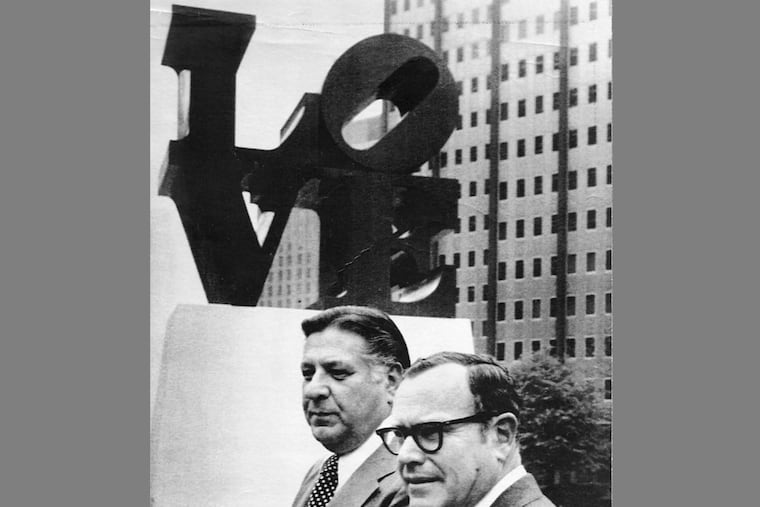Frank Rizzo's bureaucrats almost got rid of the LOVE sculpture, but Sixers owner Fitz Dixon saved it
Mayor Rizzo's city rep thought it would be fine if artist Robert Indiana gave it to the city, but there was not a penny in the budget for LOVE.

It's hard to imagine, following the artist Robert Indiana's death on Saturday, months after the ceremonious unveiling of a refurbished LOVE sculpture ensconced in a refurbished LOVE Park.
And it's hard to imagine, following the cheering and cheerful Super Bowl-style parade of the beloved artwork around Center City.
But Indiana's LOVE sculpture wasn't always embraced so enthusiastically in Philadelphia, at least by city officials.
The sculpture was a popular hit when the artist first lent it to the city for the Bicentennial celebration in 1976. But the Rizzo administration was so uninterested in the piece that it refused to acquire it, and two years later, in the dead of an April night in 1978, Indiana's New York Gallery sent a truck to Philadelphia, packed up LOVE, and drove it back to the Apple.
>> READ MORE: Why Robert Indiana's 'LOVE' sculpture means so much to Philadelphia
There was another buyer interested, and in New York, it seems, a buyer didn't think $45,000 was too much to pay for a little LOVE.
"If they'd wanted to leave it here, that would have been fine," Joseph LaSala, city representative, said the day after the city awoke to a LOVE-less park.
Apparently, Indiana's gallery had been told that the city was buying the piece, and the city had been told that the piece was on loan. So every month from June 1976 to January 1977, the gallery sent a bill to the city's Bicentennial agency, which closed down at the end of the Bicentennial year.
Nobody paid anything, or even returned the bill. Crickets from the Rizzo folks.
One city resident was taken aback on April 25, 1978, to find LOVE gone.
Anne d'Harnoncourt, then a curator of 20th century art at the Philadelphia Museum of Art, told the Inquirer she was "surprised it just vanished."
D'Harnoncourt, who would go on to become a legendary director of the museum, said she found the work "very … loving."
"I got used to it," she added
>> READ MORE: 5 other places you'll find Robert Indiana's 'LOVE' sculpture
Rachel Chodorov, director of the Denise Rene Gallerie in New York, Indiana's agent, said that Indiana was reluctant to remove the sculpture because he thought it belonged in Philadelphia and that she had tried to negotiate with the city for over a year before the truck came to haul the piece away. She had even offered to help raise funds for acquisition. But she was rebuffed at every turn.
Al Gaudiosi, LaSala's predecessor as city representative, finally made a lowball offer, which the gallery said was less than it cost to make the piece in the first place.
Following the departure of LOVE, Gaudiosi told the Inquirer that he had explained to the gallery, which wanted payment in 1977, that he was "a non-art person," he didn't know anything about art, and he might be interested if the price was "reasonable."
LaSala, who took over as city rep just weeks before the truck pulled up at John F. Kennedy Plaza to whisk LOVE away, continued in the same vein as his predecessor and said he didn't hear about the gallery's plan to repossess the piece until three days before the truck came.
"The gallery said, either you buy the thing, or we take it out," LaSala told the Inquirer. "Frankly, I was involved in the budget process. I didn't have time to consult or check it out."
That, apparently, was the wrong message. City residents expressed displeasure.
They loved the sculpture as much as they loved Erich Segal's huge best-seller and blockbuster movie, Love Story, an early 1970s tale of love and death writ in the salt of tears.
The Rizzo administration must have embraced Segal's popular phrase — "Love means never having to say you're sorry" — because nobody apologized for the departure of LOVE from the plaza.
Nobody apologized, but sometimes love has a lot of explaining to do.
And sometimes an explanation just doesn't wash.
F. Eugene Dixon Jr., owner of the 76ers, chairman of the Philadelphia Art Commission, philanthropist, sportsman, and very public member of the Widener family, read the explanations in the newspaper the week of LOVE's disappearance. He was not happy.
Dixon immediately called LaSala.
"Buy LOVE, Joe," Dixon barked into the phone. "Get it back where it belongs. Whatever it costs, I'll pay for it."
LaSala quickly reached an accommodation with the gallery, buying LOVE for $35,000 of Dixon's money.
In May, LOVE was back.
A somewhat contrite LaSala said, "It should never have left in the first place."